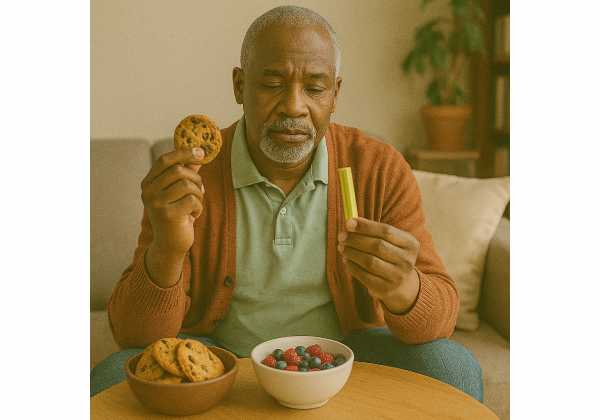
Cravings feel random, but they follow patterns. Short sleep, stress spikes, erratic meals, and fast-digesting foods push the brain toward quick energy. With age, appetite signals shift again: you may feel less hungry at mealtimes yet more vulnerable to evening nibbling. The goal isn’t perfect willpower; it’s building a routine that makes the easy choice the right one. In this guide you’ll learn how sleep debt and hormones drive cravings, the protein target per meal that steadies appetite, how to use fiber and low energy density meals for volume without overload, and when to time carbohydrates so you feel satisfied—without a late-night crash. You’ll also get practical ways to shape your environment: what to keep in view, what to pre-portion, and how to structure evenings. For a fuller picture of a longevity-friendly plate, see our overview of food patterns for long-term health.
Table of Contents
- Why Cravings Spike: Sleep Debt, Stress, and Hormonal Shifts
- Protein Targets per Meal to Tame Appetite
- Fiber Volume and Low Energy Density Meals That Satisfy
- Smart Carb Pairings and Timing to Reduce Spikes
- Environment and Routine: Cue Control and Planning
- Evening Sweet Tooth Solutions Without the Crash
- Hydration, Tea, and Other Low Calorie Allies
Why Cravings Spike: Sleep Debt, Stress, and Hormonal Shifts
Cravings are not a character flaw; they’re biology responding to context. After short sleep—often just one curtailed night—appetite-regulating hormones shift in ways that make highly palatable foods more compelling. Leptin (satiety signal) dips, ghrelin (hunger signal) rises, and brain reward networks become more reactive to food cues. The result is a stronger pull toward calorie-dense, sweet, and salty options, especially late in the day. Over weeks, repeated sleep restriction can layer on insulin resistance, making post-meal glucose swings more dramatic and further amplifying cravings.
Stress drives a similar loop. Stress hormones prime the body for quick energy and nudge choices toward fast-digesting foods. If stress also fragments sleep, the two amplify each other. Many older adults notice a particular window—midafternoon through late evening—when energy sags, focus wanes, and snack urges climb. That window is shaped by circadian biology and by what (and when) you ate at earlier meals.
Hormonal shifts with aging change appetite signals too. For many, hunger at traditional mealtimes feels blunted while hedonic appetite—“I want something tasty”—remains strong. Sarcopenia risk also rises with age; if protein at breakfast and lunch is low, the body may chase extra energy later to compensate. Dehydration, common with reduced thirst cues, can masquerade as hunger and worsen fatigue-driven cravings.
Start by observing, not judging. For seven days, track three things: (1) sleep duration and quality, (2) the time and size of meals, and (3) when cravings hit and what you choose. Patterns almost always emerge. Then address the predictable levers:
- Sleep: Protect a consistent sleep window and set caffeine and alcohol cutoffs. A single night improved may trim next-day snack pull.
- Protein distribution: Cover each meal with a specific gram target (next section) so your brain registers a “complete” meal.
- Glycemic stability: Avoid large, naked carbohydrate loads earlier in the day that set up a late dip.
- Stress circuits: Short movement bouts (5–10 minutes), controlled breathing, or getting outside blunt acute urges without relying on food.
Cravings never vanish, but with the right routine they lose urgency. You’ll still enjoy sweet or savory foods—by design, not by drift.
Protein Targets per Meal to Tame Appetite
Protein has two jobs here: it quiets hunger in the short term and protects lean mass over time. Both reduce “drive to eat.” For most adults aiming for healthy aging, a practical day target is 1.2–1.6 g protein per kg body weight (e.g., 72–96 g/day for a 60-kg person), divided across meals. If that range feels high today, step up gradually; even moving from 0.8 g/kg/day toward 1.0–1.2 g/kg/day can curb cravings.
Per-meal targets that work in real life
- Breakfast: 25–35 g. Examples: Greek yogurt (200 g) with whey or soy isolate (10–15 g), eggs (2) plus cottage cheese, or tofu scramble with edamame.
- Lunch: 30–40 g. Examples: lentil bowl with quinoa and pumpkin seeds; chicken or tempeh salad with beans.
- Dinner: 25–35 g. Examples: fish with white beans and greens; high-protein pasta with turkey or seitan.
Why the emphasis on breakfast and lunch? Older adults experience anabolic resistance—the muscle-building response to protein is blunted, so the brain and muscles need a clearer “signal.” Hitting a firm protein threshold early reduces late-day drive to eat and supports steadier energy.
Food-first combinations that keep you full
- Protein + fiber + water-rich produce = volume and staying power. Think: salmon, bean-and-veg salad, olive-oil vinaigrette.
- Soup or stew starters—chicken and barley, minestrone, miso with tofu—add volume at low energy density, setting a natural cap on later intake.
Snack strategy
If you need something between meals, choose 10–20 g protein with minimal sugar: skyr, cottage cheese, edamame, jerky with sliced veg, or a protein shake with milk or soy. Keep it small and purposeful; aim to carry you to the next proper meal rather than replace it.
Practical tip: Pre-portion proteins for the week—cooked legumes, grilled fish or chicken, marinated tofu, or baked tempeh—so assembling a high-protein plate takes minutes, not willpower. For specifics on spacing and thresholds, see per-meal protein planning.
Fiber Volume and Low Energy Density Meals That Satisfy
Cravings often track with volume: when plates look skimpy, the brain keeps asking for “more.” Fiber and water fix that. Build meals with low energy density (fewer calories per gram) so portions look generous, chew longer, and leave your stomach comfortably stretched—a potent fullness signal.
Daily fiber goal: 25–35 g/day, increased by ~5 g every 3–4 days if you’re starting low. Aim for a mix of gel-forming soluble fibers (oats, barley beta-glucans, psyllium, fruit pectins) and insoluble fibers (vegetable skins, whole grains) to combine moisture with bulk.
Compose a low energy density plate
- Half the plate non-starchy vegetables (roasted, sautéed, or raw): tomatoes, leafy greens, peppers, zucchini, mushrooms.
- A hearty legume or whole grain: lentils, chickpeas, black beans, farro, barley, intact oats.
- Lean or plant protein in the range from the previous section.
- Flavor without a flood of calories: vinaigrettes, citrus, herbs, spices, pickled elements.
Volume-forward meals and why they work
- Vegetable and bean soups: Broth adds water without many calories; beans add fiber and protein for staying power.
- Salad-mains: Use 2–3 cups of vegetables plus a warm topper (grilled fish, roasted chickpeas, tofu).
- Stir-fries: Load the pan with vegetables first, then add protein and a measured sauce. Serve over cauliflower rice plus a small scoop of rice for satisfaction with fewer calories.
Make fiber frictionless
- Keep ready-to-eat produce washed and chopped.
- Cook a pot of beans weekly; freeze in single portions.
- Stir 1–2 Tbsp ground flaxseed into breakfast or soup; it adds fiber with minimal flavor change.
What to watch
- Coarse bran or sudden, large fiber jumps can cause gas and cramping. Ramp gradually and drink water with fiber-rich meals so gels form properly.
- “Healthy” snack mixes can still be calorie-dense. Compare portions by weight, not volume.
If you want a structured overview of fiber types and food sources, browse our concise guide to building a higher-fiber day.
Smart Carb Pairings and Timing to Reduce Spikes
Carbohydrates aren’t the enemy; unbuffered carbohydrates are. Pair carbs with protein, fat, and fiber to slow digestion and flatten glucose spikes—an approach that reduces the post-meal “crash” that often triggers cravings a few hours later.
Pairing rules that work
- Add protein first. A cup of Greek yogurt under fruit; eggs or tofu with toast; beans in the pasta bowl.
- Include viscous fiber. Oats, barley, chia, flax, psyllium, pectin-rich fruit (apples, pears, berries) reduce gastric emptying and blunt peaks.
- Use fats strategically. A measured tablespoon of olive oil or a handful of nuts can smooth absorption while improving flavor and satisfaction.
Timing matters
- Front-load carbohydrates earlier if you’re active in the morning or midday; your muscles act like a sink for glucose, which reduces spikes.
- Go lighter at dinner with starch (a fist-sized portion) and emphasize vegetables and protein; this decreases late-evening cravings and improves sleep quality.
- Post-meal movement (10 minutes)—strolls, light chores, or a few flights of stairs—meaningfully lowers the glucose curve.
Choose smarter carbs
- Intact grains and legumes: steel-cut oats, barley, farro, brown/red rice, lentils, chickpeas, black beans.
- High-fiber fruits: berries, apples, pears, oranges; pair with protein.
- Starch swaps: roasted root vegetables for part of the grain; higher-fiber pasta; or mix 50:50 rice with riced cauliflower.
Breakfast examples for steadier energy
- Oats cooked with milk, chia, and egg whites; top with berries and walnuts.
- Tofu or egg scramble with vegetables plus a small side of fruit.
- Skyr bowl with ground flax and a measured serving of granola (¼–⅓ cup) for crunch without a sugar surge.
If you’re interested in the mechanics and menu moves that keep glucose curves modest, see our primer on lower glycemic load tactics.
Environment and Routine: Cue Control and Planning
Environment quietly decides what—and how much—you eat. Cravings are most persuasive when your plan is vague, your kitchen is chaotic, or tempting foods sit in view. Shape your surroundings so routine, not willpower, does the heavy lifting.
Reset what you see first
- Counter rule: Keep fruit, cut vegetables, and sparkling water visible; store sweets and chips out of sight or outside the home.
- Single-serve portions: Pre-portion nuts, trail mix, and dark chocolate; avoid family-size bags that invite “just a little more.”
- Plate and bowl size: Use 8–9 inch plates on weeknights; they naturally right-size portions without feeling scarce.
Decide once with a default week
- Two rotating breakfasts and two rotating lunches reduce decision fatigue.
- Theme dinners (beans-and-greens Monday, fish-and-veg Wednesday, soup-and-salad Friday) simplify shopping and make healthy choices feel automatic.
- Proteins on hand: Keep shelf-stable or frozen options (tuna, sardines, beans, edamame, tempeh) queued up so “no time” doesn’t mean “no protein.”
Pre-commit the tricky windows
- Midafternoon often needs structure. Put a 10–20 g protein snack on your calendar and pair it with 5–10 minutes of movement.
- Evenings benefit from ritual replacements: herbal tea, a short walk, or a phone call during your usual snack hour.
Social and travel tactics
- Scan menus online and decide your order before you’re hungry.
- Lead with a salad or broth-based soup; ask for a protein add-on.
- Set a “max portions” rule for bread baskets and shared desserts (e.g., two slices or two forks’ worth).
Tiny scripts for big gains
- “I don’t keep that at home” diffuses offers without debate.
- “I already decided my dinner” protects your plan from last-minute impulses.
If you like working from a plan, our guide to simple meal prep shows how to stock a protein-and-produce kitchen in under an hour.
Evening Sweet Tooth Solutions Without the Crash
Evening is prime time for cravings—stress exhale, decision fatigue, and circadian dips converge. Solve for physiology and ritual at the same time.
Start upstream
- Eat enough at dinner. Skimping sets up a snack raid. Aim for your protein target, two cups of vegetables, and a modest starch.
- Close the kitchen on time. Finish dinner 3–4 hours before bed. Late heavy meals disrupt sleep and rebound hunger the next day.
- Create a wind-down routine that doesn’t involve the pantry: a short walk, light stretching, a hot shower, then herbal tea.
Satisfy the sweet signal smartly
- Protein-plus-sweet pairings:
- Greek yogurt with berries and cinnamon; optional drizzle of honey.
- Cottage cheese with sliced peaches or pineapple.
- Protein pudding: blend skyr, cocoa powder, and a dash of milk; top with a few chocolate chips.
- Built-in portion controls:
- Two squares of dark chocolate (70–85%) alongside tea.
- A small baked apple with cinnamon and walnuts.
- Frozen grapes or cherries in a bowl (pre-portioned).
Guardrails that keep you on track
- Serve dessert in a small dish at the table, not from the package.
- Pair it with herbal or decaf tea in a mug you like; the hand-to-mouth ritual and warmth signal “done.”
- Keep no-cook backups for low-energy nights: pre-cut fruit, high-protein yogurt cups, pre-portioned nuts.
If cravings still overrun your evening
- Check your breakfast and lunch protein—many people under-eat early and overeat late.
- Add 10 minutes of gentle movement after dinner to steady glucose.
- Try a fiber booster with dinner (chia or psyllium stirred into yogurt) if stools are firm and evening hunger is persistent.
For more ideas that hit the sweet spot without the sugar crash, see our quick list of smarter dessert ideas.
Hydration, Tea, and Other Low Calorie Allies
Mild dehydration masquerades as hunger and fatigue. With age, thirst cues can fade, diuretics are more common, and outdoor time may drop—all of which nudge cravings up. Strategic hydration and low-calorie beverages help on several fronts: they add volume, warm or cool the body, and provide a satisfying ritual when you want “something.”
Set a simple baseline
- Aim for ~30 ml/kg/day of fluids from beverages and water-rich foods, adjusting for heat, activity, and medications. Front-load earlier: 500–700 ml before noon supports morning energy and reduces evening thirst (which can feel like hunger).
Use beverages to your advantage
- Water first. A glass of water or sparkling water before meals and snacks can blunt immediate urgency. Keep a bottle visible on your desk or counter.
- Broth, soups, and stews. Warm, savory liquids are filling at low energy density and pair well with vegetables and beans.
- Tea and coffee (timed). Most adults do well with 1–3 cups/day before early afternoon. Black tea, oolong, green tea, and coffee offer polyphenols that may modestly support appetite control and alertness. If caffeine is sleep-disruptive, shift to decaf or herbal after midday.
- Milk or soy drinks. A small glass (150–200 ml) delivers fluid plus protein; useful for a purposeful snack but not for mindless sipping.
Flavor without calories
- Infuse water with citrus, cucumber, mint, or berries. Keep a pitcher ready.
- Make iced herbal tea on weekends (peppermint, rooibos, hibiscus) and store in the fridge.
Tactical habits
- Pair every snack with a cup or glass. The hand-to-mouth ritual and temperature contrast help draw a line under eating.
- Use a mug you like for evening herbal tea; the cue becomes part of your wind-down routine.
- On social nights, alternate alcohol with sparkling water and bitters or a squeeze of citrus.
When hydration isn’t enough
- If urges persist after a glass of water and a five-minute pause, you likely need protein or a real meal, not a beverage. Reach for a small, protein-forward option you’ve prepped.
Cravings thrive on chaos and scarcity. Hydration rituals, like meal routines, are small structures that make better choices automatic—even at the end of a long day.
References
- Sleep Deprivation and Central Appetite Regulation (2022) (Review)
- Effects of acute sleep loss on leptin, ghrelin, and adiponectin in adults with healthy weight and obesity: A laboratory study (2023)
- Clinical Evidence and Mechanisms of High-Protein Diet-Induced Weight Loss (2020) (Review)
- Dietary energy density: Applying behavioural science to weight management (2017) (Review)
- The role of low glycemic index and load diets in medical nutrition therapy: a critical review (2024) (Review)
Disclaimer
This article is educational and does not replace individualized medical advice. Nutrition needs vary with health conditions, medications, allergies, and personal goals. Speak with your clinician or a registered dietitian before changing your diet, supplements, or routine—especially if you manage diabetes, kidney disease, or cardiovascular conditions.
If this guide was helpful, please consider sharing it on Facebook, X, or any platform you prefer, and follow us for future updates. Your support helps us continue producing clear, evidence-based resources for healthy aging.










